Shahid Alam
The art of Arabic calligraphy has taken a special place in my artistic activity.
I am fascinated by the manifold design possibilities of a word that only comes into being through the unique art of connecting the letters. The letters sacrifice their individual form, join together and then connect with each other. This is how a new art of word sculptures is created.

Shahid Alam – The Calligrapher
Shahid Alam was born in Lahore, Pakistan, into a family in which the art of calligraphy had been cultivated and handed down over several generations. At the age of four, he already took up the pen and began to playfully practise his hand in Arabic calligraphy. He received regular calligraphy lessons during the first three years of schooling at “Danish Gah” (a public school run by the well-known poet Ehsan Danish); during the seven years of schooling at the Catholic Franciscan school in Lahore, he consolidated and refined the early basics. As a maturing artist, calligraphy is the free space of his artistic creation.
To take up his studies in Germany, he studied German for two years at the Goethe Institute in Lahore, where he became acquainted with the language and poetry of Goethe, and also personally with the world-renowned Orientalist Prof. Annemarie Schimmel, who intensively accompanied his career as a calligrapher until her departure in 2003.
He came to Germany as a young student in 1973, where he studied art, education, political science and European studies. He taught for over two decades in various schools and educational institutions, mainly in Germany, but in the meantime also in his home country Pakistan. Since 1996 he has been working as a freelance artist and now lives in Stolberg near Aachen.
The cultural and religious diversity in his homeland against the background of the political and economic antagonisms there have decisively shaped his life and his deeply sacred art. Today, in the freedom of the European public, he puts this art of his at the service of intercultural and interreligious dialogue, which is carried by the aesthetics and beauty of Arabic written culture and from there opens up new paths of mediation and mutual understanding. As an artist, he succeeds in building a bridge between Orient and Occident. He is decisively involved in an intercultural and interreligious understanding that is supported by the aesthetics of Arabic script. His works are visualisations of poetry by great literary figures and mystics such as Goethe, Schiller, Rilke, Rumi, Ibn Arabi and others, which he skilfully incorporates into his works as translations, but also in the original languages.
Learn more
The cultural and religious diversity in my country of origin, Pakistan, against the backdrop of the political and economic antagonisms there have had a decisive influence on my life and art.
Today, in the freedom of the European public, I place my art at the service of intercultural and interreligious dialogue, which is carried by the aesthetics and beauty of Arabic written culture and from there opens up new paths of mediation and mutual understanding.
It is therefore not surprising that Christian churches of various denominations have opened their doors to Islamic calligraphy from my hand; since 2006, 33 exhibitions have already taken place in Catholic, Protestant and Reformed churches.
INTERCULTURAL AND INTERRELIGIOUS UNDERSTANDING
The Aesthetics of Arabic Script in the Service of Intercultural and Interreligious Understanding.
Through the aesthetics of Arabic script and the art of Islamic calligraphy, I build bridges between Orient and Occident. My exhibitions in Christian churches are not a matter of course. By opening its doors to Islamic art, the church is thus taking a great and courageous step for world peace. The public was astonished at the opening of the exhibition in St. Peter Aachen in 2007, when Bishop Heinrich Mussinghoff opened the exhibition with his lecture on the first Qur’anic scripture Fatiha. The overwhelming number of visitors to all my exhibitions clearly proves that a broad public very much welcomes this approach.
INITIATE DIALOGUES
“The dialogue of religions is more urgent than ever in the face of today’s world situation. History belongs to people who bring together what was once separate; walk life paths that were once blocked.”
K. J. Kuschel – Life is Building Bridges
The calligraphically pictorial poems by great poets and mystics such as Goethe, Rilke, Hölderlin, Rumi, Ibn Arabi, Mansur Hallaj and others – in the Arabic translation and also in the original script – form another bridge for the viewer. The translations of the Arabic poems into German and the German poems into Arabic are literally the bridges to other shores. Not only the artistic realisation of the Arabic texts, but also their content is important for understanding an art that attempts to build a bridge between Orient and Occident and to come a little closer to Friedrich Rückert’s vision of “world poetry alone is world reconciliation”.




